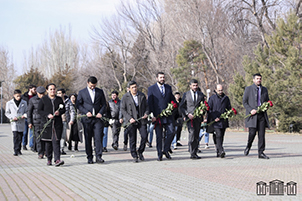19.01.2024

A group of Armenian National Assembly deputies visited Tsitsernakaberd to pay tribute to the victims of the 1990 Baku pogroms. They laid flowers at the khachkar erected in memory of the victims of those massacres organised by the Azerbaijani government.
Out of the 1.7 million residents of Baku, capital of Soviet Azerbaijan, over 200,000 were Armenians. It is noteworthy that, since the beginning of the Karabakh movement, the issue of their safety and future has been linked to the Karabakh conflict by both the Azerbaijani and the top Soviet leadership. Mikhail Gorbachev, General Secretary of the Central Committee of the Communist Party of the Soviet Union, during a meeting that took place on February 25, 1988, put the question to Zori Balayan and Silva Kaputikyan, saying, "Have you considered the fate of the 207,000 Armenians living in Baku?"
As a result of a series of massacres in February 1905, September 1918, February 1988, and January 1990, Baku was completely emptied of its Armenian population. The 1990 Baku Armenian pogroms were carried out with the close cooperation of the Azerbaijani authorities and the Azerbaijani Popular Front.
Soviet troops entered the city only when the Soviet regime was threatened. The Baku Armenian massacres resulted in more than 400 deaths, though an investigation into the massacres of the Armenian population was never carried out. Perceived by Armenians as “another genocide”, these massacres were again not condemned.
The official non-recognition of the Armenian Genocide by some leading people in the world community and the decades-long active denialist policy of the Turkish authorities contribute to the continuation of genocidal acts. This was clearly demonstrated in September-November 2020 and September-October 2023, when, for the first time in history, Artsakh was completely emptied of Armenian population.





